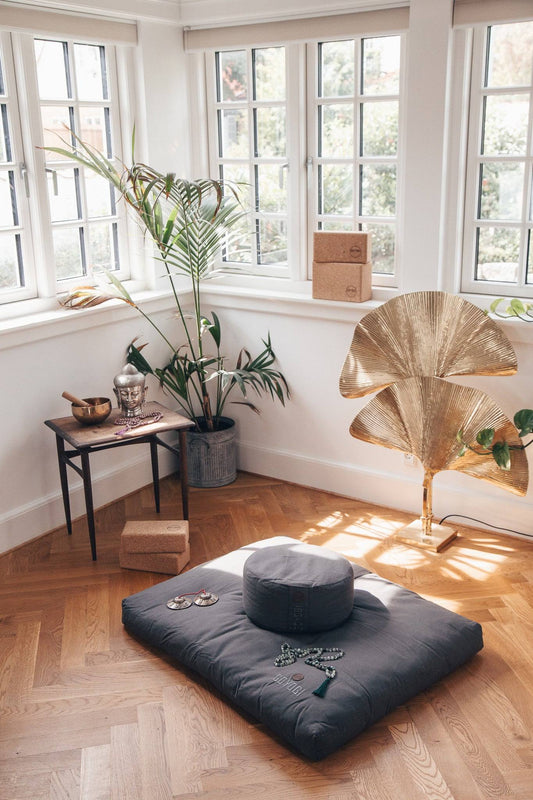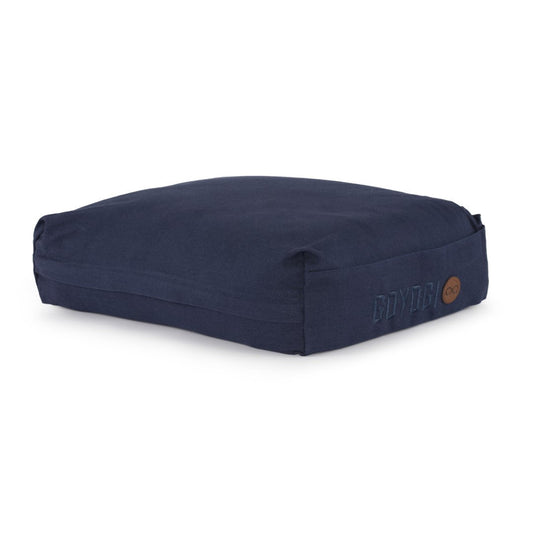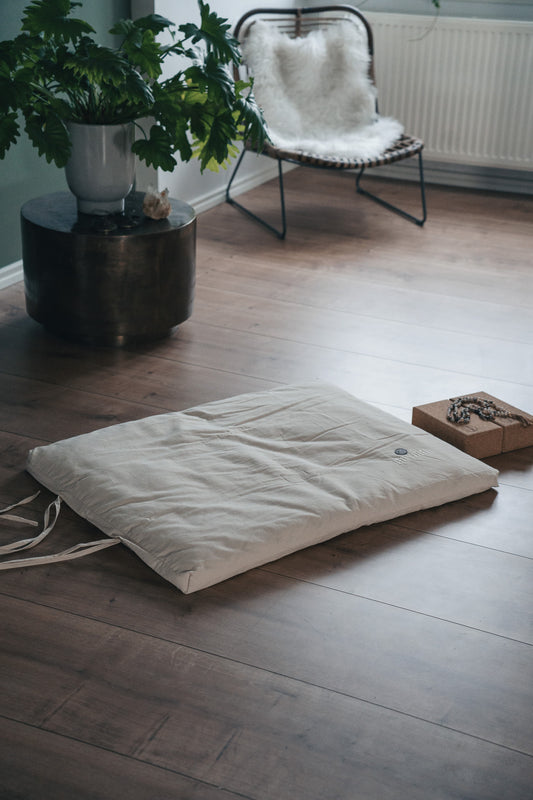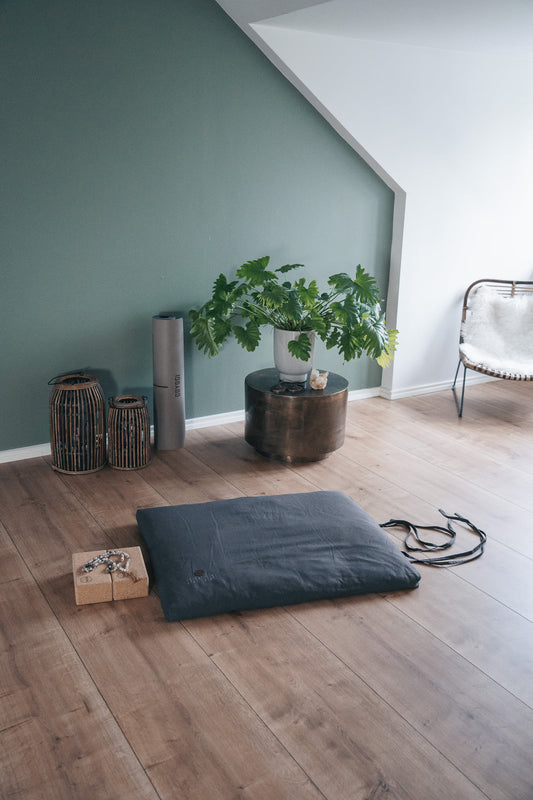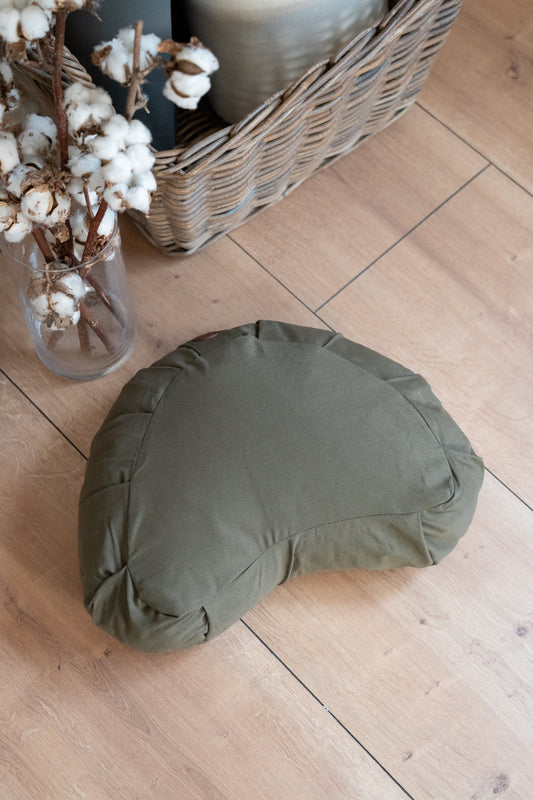Guide: Den gode siddestilling i meditation
For at sidde godt under meditation er det vigtigt, at rygsøjlen bevarer sin naturlige dobbelt-S-form, og at bækkenet er neutralt eller let fremadkippet (let anterior pelvic tilt).
Dette sikrer, at din positur er aktiv uden at være anspændt, og at du kan sidde længere tid uden ubehag.
En god meditationspude løfter hofterne, så knæene kan hvile lavere end bækkenet, hvilket aflaster lænden og skaber stabilitet. Hvis du har svært ved at sidde i skrædderstilling, kan du også sidde i diamantstilling (Vajrasana) på en bolster, hvis du ikke kan sidde i skrædderstilling.
Vi anbefaler altid at bruge en zabuton (en stor, flad meditationspude) under dine knæ og underben for ekstra komfort.

Find den rette meditationspude
Valget af meditationspude afhænger af din erfaring, smidighed og hvor længe du sidder ad gangen.
Til begynderen: Rund meditationspude
Vores runde meditationspude er et godt valg, hvis du er ny i meditation. Den løfter hofterne 14 cm, hvilket gør det lettere at sidde i en stabil stilling uden at belaste knæ og lænd. Boghvedeskallerne i fyldet former sig efter kroppen og giver en behagelig, men fast støtte.
Bedst til:
- Dig, der lige er begyndt med meditation og har brug for højde på puden
- En alsidig praksis med både yoga, meditation og mindfulness
- Kortere til længere meditationssessioner
🔗 Shop rund meditationspude her
Til den smidige og/eller øvede: Halvmåneformet meditationspude
Hvis du har mere erfaring med siddende meditation og en god hofteåbning, vil vores halvmåneformede meditationspude (Crescent) være et godt valg. Formen giver god støtte til hofterne og hjælper knæene med at falde naturligt ned mod gulvet.
Bedst til:
- Dig, der har god fleksibilitet i hofterne
- Siddende meditation med anklerne tæt på kroppen i skrædderstilling
- Kombination med en zabuton for optimal komfort
🔗 Shop halvmåneformet meditationspude her
Til langvarig meditation: Zafu meditationspude
Vores zafu meditationspude har en bredere og højere form, der giver ekstra støtte til hofter og ben. Formen sikrer en ergonomisk siddestilling med optimal vægtfordeling, hvilket gør den ideel til dig, der mediterer i længere tid ad gangen.
Bedst til:
- Langvarig meditation
- Dig, der ønsker en let tilpasselig pude (justerbart fyld)
- En dedikeret praksis med fokus på komfort og ro
🔗 Shop Zafu meditationspude her
Til diamantstillingen og alternativ siddeposition: Calm bolster
Hvis du ikke kan sidde i skrædderstilling, kan du sidde i diamantstilling (Vajrasana) på en Calm bolster. Dette giver dig muligehed for at skabe en god S-form på din rygsøjle og en naturlig oprejst siddeposition.
Vores rektangulære bolster kan også bruges som meditationspude i både skrædderstilling og diamantstillingen.
Bedst til:
- Dig, der ikke sidder komfortabelt i skrædderstilling
- Siddende meditation i Vajrasana
- Understøttelse af ryg og lænd i yin og restorativ yoga
🔗 Shop Calm bolster og rektangulær bolster her
Sådan sidder du komfortabelt i meditation
1️⃣ Sæt dig på kanten af puden med bækkenet let fremadkippet. Dette hjælper med at skabe den naturlige S-kurve i rygsøjlen.
2️⃣ Lad knæene hvile lavere end hofterne – brug en zabuton under knæ og underben for ekstra støtte.
3️⃣ Løft brystet let og sænk hagen en smule for at holde en rank, men afslappet positur.
4️⃣ Slip spændinger i skuldre og arme, og hvil hænderne i skødet eller på knæene.
Når du sidder korrekt, vil du mærke en følelse af stabilitet og lethed – en balance mellem aktiv støtte og afslapning.
Find din perfekte meditationspude hos GOYOGI
Uanset om du er nybegynder eller erfaren, har vi en meditationspude, der støtter din praksis og giver dig den komfort, du har brug for.
🔗 Se hele vores udvalg af meditationspuder her










